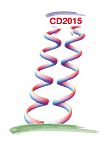Speaker
Roman Skibinski
(Jagiellonian University, Krakow)
Description
In the recent decade the chiral Effective Field Theory (χEFT) has proven its predictive power in low energy nuclear physics. Within this approach the two- and three-nucleon (3N) forces have been derived perturbatively in a consistent manner [1,2]. The three-nucleon force (3NF) occurs for the first time at the next-to-next-to leading order (N2LO) of chiral expansion. Inclusion of N2LO 3NF to study three-nucleon processes has revealed an overall good agreement between theoretical predictions and data [3]. The quality of data description is similar to those obtained with semi-phenomenological potentials. The remaining discrepancies are partially related to poor spin structure of these chiral forces. The further improvement in data description is expected when higher order chiral forces will be taken into account. Unfortunately, the 3NF at the next order (N3LO) has much more complex structure [4,5] and its inclusion in theoretical studies is much more challenging. In recent papers [6,7] we have studied the role of full chiral N3LO 3NF in a description of the nucleon-deuteron elastic scattering and the deuteron breakup and found no improvement in data description. Moreover unnaturally large values of the two free parameters (low energy constants) of this 3NF have to be used to describe 3H binding energy and the neutron-deuteron doublet scattering length. The studies [6,7] already accelerated work on the new generation of chiral NN and 3N forces. Recently, the improved chiral NN potentials up to N3LO [8] and N4LO [9] have been derived by E.Epelbaum and collaborators. The most interesting feature of theses forces is avsubstantial reduction of the cut-off artifacts in comparison with the older models used in [6,7]. In this contribution the first results obtained with these very new forces up to N4LO for the deuteron photodisintegration process, the nucleon-deuteron radiative capture and the muon capture on the 3He will be reported. Since the consistent chiral nuclear electro-magnetic and weak currents are not available yet, we have included the electromagnetic meson exchange currents via the Siegert theorem. In all cases the convergence of the theoretical predictions in respect to chiral expansion as well as the dependence of predictions on cut-off parameters of the used forces will be discussed.
References
1. E. Epelbaum, H.-W. Hammer, Ulf-G. Meißner, Rev.Mod.Phys. 81, 1773 (2009).
2. R. Machleidt, D.R. Entem, Phys. Rept. 503, 1 (2011).
3. E. Epelbaum et al., Phys. Rev. C66, 064001 (2002).
4. V. Bernard et al., Phys. Rev. C77, 064004 (2008).
5. V. Bernard et al., Phys. Rev. C84, 054001 (2011).
6. H. Witala et al, J. Phys. G: Nucl. Part. Phys. 41, 094011 (2014).
7. J. Golak et al., Eur. Phys. J. A50, 177 (2014).
8. E. Epelbaum et al., arXiv:1412.0142 [nucl-th].
9. E. Epelbaum et al., arXiv:1412.4623 [nucl-th].
Primary author
Roman Skibinski
(Jagiellonian University, Krakow)
Co-authors
Mr
Alaa Elmeshneb
(Jagiellonian University)
Prof.
Henryk Witała
(Jagiellonian University)
Prof.
Jacek Golak
(Jagiellonian University)

